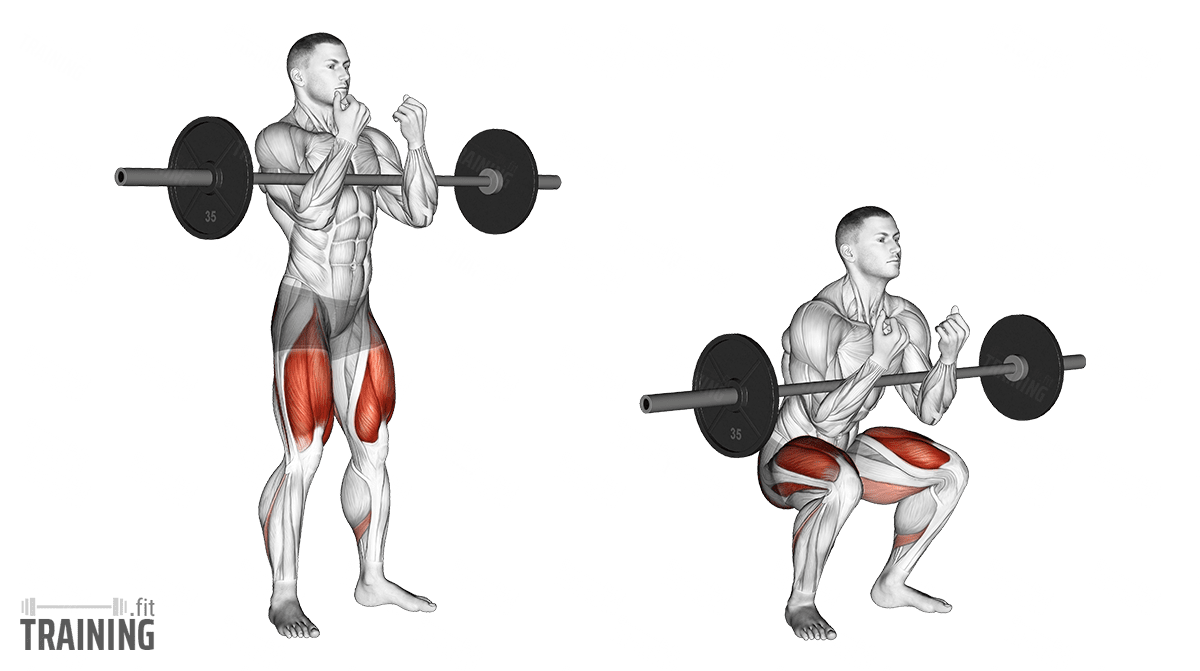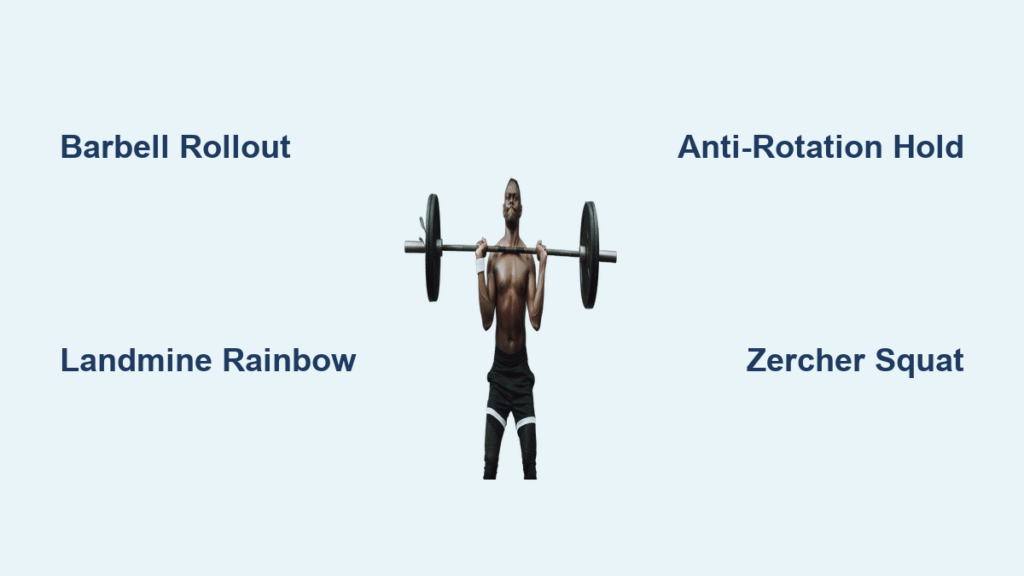Your core isn’t just about six-pack abs—it’s the powerhouse that connects your upper and lower body in every movement. While bodyweight exercises have their place, adding a barbell to your core training unlocks new levels of strength, stability, and muscle development that simply can’t be achieved through planks and crunches alone. A core barbell workout creates the mechanical tension necessary for visible abdominal development while building functional strength that transfers directly to your heavy lifts and everyday movements.
Whether you’re struggling to break through a strength plateau in your squats and deadlifts, or you’re looking to build the defined midsection that diet alone hasn’t delivered, barbell core training offers the solution. This guide walks you through proven exercises, programming strategies, and safety protocols to transform your core training from basic to brutal—without risking spinal injury or wasting time on ineffective movements.
Why Your Core Needs Barbell Resistance
Progressive Overload for Visible Ab Development
Unlike bodyweight movements that plateau quickly, barbell exercises let you add weight in small increments. Start with just the 45-pound bar and add 2.5-5 pounds weekly. Your abs respond like any other muscle—progressive overload creates the mechanical tension needed for growth and definition beyond what leanness alone provides. The empty Olympic bar (45 pounds) delivers immediate resistance your core muscles must overcome, triggering hypertrophy that kitchen-floor crunches simply can’t match.
Multi-Plane Stability Challenges
Barbell exercises challenge your core through angles impossible with floor work. When you hold weight overhead or resist rotation during landmine movements, you’re engaging deep stabilizers and obliques in ways that translate directly to athletic performance and injury prevention. This multi-angle resistance builds the rotational stability that protects your spine during heavy lifts and everyday movements—something no standard plank can replicate.
Essential Setup for Core Barbell Training

Your DIY Landmine Solution
Don’t have a commercial landmine? Roll a thick towel, wedge it into a corner, and trap one end of the barbell for an instant anchor point. This setup enables critical anti-rotation exercises like the Landmine Rainbow that build the oblique strength needed for heavy squats and deadlifts. Always test your DIY landmine’s stability before loading plates—watch for any shifting or slipping during initial movement.
Critical Safety Checks Before Every Session
Never skip these steps:
– Inspect collars and plate security (loose plates = dangerous imbalance)
– Verify landmine anchor stability with light test movements first
– Clear 6 feet of space around your workout area
– Check barbell for bends or damage that could compromise safety
Anti-Rotation Power Builders
Landmine Rainbow Technique for Unbreakable Obliques
Stand facing your landmine anchor with both hands on the bar at eye level. Lock your hips and shoulders square, then sweep the bar in a controlled rainbow arc without letting your trunk rotate. This brutal move targets your obliques and deep core stabilizers as they prevent unwanted movement. Pro tip: Start with just a 25-pound plate on the sleeve—your core will fatigue faster than you expect.
Programming: 3 sets of 8-10 reps per side with 30-pound load
Progression: Increase arc width before adding weight to maintain clean form
Anti-Rotation Hold to Prevent Spinal Collapse
From chest-level extended-arm position, slowly lower the bar to one side without any hip or torso twist. Return to center and alternate sides. This pure anti-rotation drill builds the stability needed for heavy squats and deadlifts. If you struggle with form, regress by decreasing your range of motion or using larger plates (the longer lever creates lighter torque at your core).
Kneeling Barbell Rollout Mastery
Proper Execution for Maximum Ab Activation
Load 45-pound plates on the bar for easier rolling. Kneel behind the bar, hands shoulder-width on the sleeve. Brace your core, squeeze glutes, and roll forward until hips nearly touch floor without arching your back. Pull back using pure abdominal control—never using momentum. The moment your lower back starts to sag, you’ve gone too far.
Progression Path:
– Weeks 1-2: Larger plates for easier rolling
– Weeks 3-4: Smaller plates increase difficulty
– Week 5+: Transition to feet rollout for advanced challenge
Critical Mistakes to Avoid:
– Hyperextending lower back – Keep ribs down, glutes tight
– Using shoulders instead of abs – Initiate movement from core
– Rolling too far – Stop before losing lumbar control
Squat-Based Core Bracing Drills

Zercher Squat for Anterior Core Strength
Cradle the barbell in your elbow crooks, hands clasped at chest. This awkward position demands extreme anterior core bracing to prevent forward collapse. Descend below parallel while keeping torso tall, then drive through heels to stand. Key cue: Imagine someone is about to punch you in the gut—brace hard before each rep.
Coaching Cues: Maintain flat lower back, retract shoulder blades throughout movement
Regression: Swap for goblet squat with kettlebell for lighter load
Front Squat Core Focus for Upright Stability
With the bar on your front delts and elbows high, maintain an upright torso throughout the movement. This position forces massive abdominal and oblique bracing as you resist forward lean. The moment your elbows drop, your core has failed—reset immediately. Pro tip: Practice box front squats first to master the upright torso position before adding significant weight.
Hip-Hinge Core Integration
Stiff-Leg Good Morning for Posterior Chain Strength
With bar on upper back and soft knees, hinge at hips until torso approaches parallel. Return explosively while maintaining rigid core. This movement builds hamstring flexibility and teaches proper hip hinge mechanics while overloading the posterior chain. Warning: Stop immediately if you feel any pulling in your lower back—this indicates lost spinal alignment.
Load Example: 3 sets of 8 reps at 40 pounds
Form Check: Place one hand on lower back—if you lose the natural curve, reset
Unilateral Fulcrum Deadlift for Anti-Lateral Stability
Load only one end of the barbell. Stand hip-width with bar against your thigh, then hinge until torso parallels floor while preventing the bar from dropping to the loaded side. This advanced variation trains anti-lateral flexion and rotational stability. Prerequisite: Master standard deadlift technique first—this exercise magnifies any form flaws.
Core Barbell Workout Programming
Weekly Integration Strategies
Integrate barbell core work 2-3 times weekly:
– Option A: 2 dedicated 15-minute core sessions
– Option B: Add 2-3 barbell core drills to full-body days post-main lifts
Volume Parameters: 2-4 sets per exercise, 6-12 reps for strength/hypertrophy, 30-60 second carries. Never train core to failure—maintain strict form throughout.
Lean & Burn Circuit (12 Minutes)
Perform 3 rounds with 60 seconds rest between movements:
1. Barbell Ab Rollout – 7 reps (focus on slow return)
2. Landmine Core Rotation – 8 reps/side at 30 lb
3. Standing Oblique Crunch – 8 reps/side at 35 lb
4. Stiff-Leg Good Morning – 8 reps at 40 lb
5. Rack Pull – 8 reps at 75 lb
Safety and Form Fundamentals
The Bracing Breath Technique
Inhale deeply into your belly and sides to create 360-degree tension before movement, exhale forcefully through the sticking point. This creates a natural weightlifting belt with your musculature—critical for all barbell core work. Practice this breathing pattern standing without weight first.
Glute Activation Protocol
Actively squeeze glutes during roll-outs and anti-rotation drills to stabilize your pelvis and prevent lower back stress. Think “glutes to hamstrings” connection—your glutes should fire before your abs during extension movements. Test: Can you maintain glute squeeze while lifting one foot slightly off the floor?
Progression Without Pain
Weekly Increases That Work
Add 2.5-5 pounds or increase range/distance weekly—but only if you maintain perfect form. Track your progression in a training log to ensure consistent overload without ego lifting. Red flag: If your reps drop more than 30% with a 5-pound increase, you’ve jumped too high.
Warning Signs to Stop Immediately
- Sharp lower back pain (not muscle fatigue)
- Loss of bowel/bladder control (seek medical attention)
- Numbness or tingling in legs
- Inability to maintain neutral spine for 3 consecutive reps
Build your strongest, most defined core by incorporating these barbell movements into your routine. Start conservative with the empty bar, progress systematically, and watch your core strength—and performance in all lifts—skyrocket. The iron core you build today will protect your spine for decades to come while delivering the functional strength and visible definition that bodyweight work alone can’t match. Your journey to a truly powerful midsection starts with that first barbell rollout—don’t wait for “someday” to begin.




